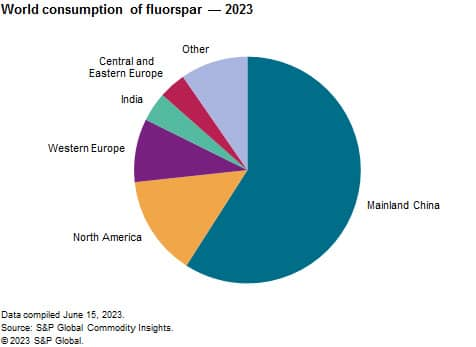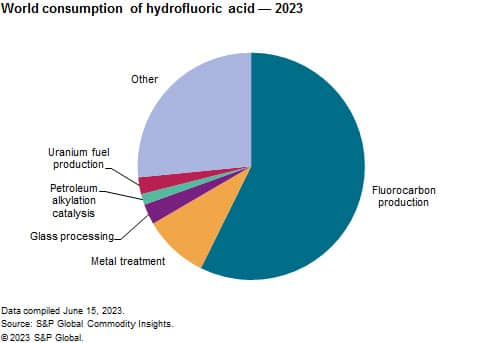Published July 2023
This report covers fluorspar and its major derivative, hydrofluoric acid, as well as providing additional data on aluminum fluoride, cryolite and fluorosilicic acid. Fluorspar is a mineral from which more than 95% of all fluorine-based compounds are derived. Hydrofluoric acid is the most important chemical derived from fluorspar and accounts for more than half of global fluorspar consumption in 2023, followed by use for aluminum smelting and steel manufacturing.
Although 20 countries have the ability to produce significant quantities of fluorspar, the majority of the world’s fluorspar production has become concentrated in mainland China, which accounted for more than half of world production in 2022. The next-largest producers are North America (Mexico), Mongolia, and Africa. Historically, the majority of mainland China’s fluorspar production was exported, but after a decade of building and growing its fluorinebased chemical industry, mainland China adds value to its domestic acid-spar supply through the production of downstream products such as hydrofluoric acid, fluorocarbons and fluoropolymers, rather than exporting the mineral.
The following pie chart shows world consumption of fluorspar:

World demand for fluorspar will grow at an average annual rate of about 2%-3% during 2023–28.
Hydrofluoric acid is the major end use market for fluorspar, accounting for more than half of fluorspar consumption in 2023. The following pie chart shows world consumption of hydrofluoric acid:

Hydrofluoric acid is the raw material for the production of fluorocarbons, which are used in refrigeration and air conditioning, and as a precursor to fluoropolymers and elastomers. In addition, hydrofluoric acid serves as a catalyst in petroleum alkylation, a process used for gasoline manufacture. It is also used in metal treatment, uranium fuel production and as a raw material in the manufacture of inorganic fluorine compounds, including most inorganic fluorides as well as elemental fluorine. Many changes are looming in the fluorocarbon industry over the next 15 years, as hydrochlorofluorocarbons (HCFCs) are being restricted and gradually substituted by gases with a lower global warming potential.
For more detailed information, see the table of contents, shown below.
S&P Global’s Chemical Economics Handbook – Fluorspar, Fluorosilicic Acid (FSA), Hydrofluoric Acid (HF) and Inorganic Fluorine Compounds is the comprehensive and trusted guide for anyone seeking information on this industry. This latest report details global and regional information, including

Key benefits
S&P Global’s Chemical Economics Handbook – Fluorspar, Fluorosilicic Acid (FSA), Hydrofluoric Acid (HF) and Inorganic Fluorine Compounds has been compiled using primary interviews with key suppliers and organizations, and leading representatives from the industry in combination with S&P Global’s unparalleled access to upstream and downstream market intelligence and expert insights into industry dynamics, trade and economics.
This report can help you
- Identify trends and driving forces influencing chemical markets
- Forecast and plan for future demand
- Understand the impact of competing materials
- Identify and evaluate potential customers and competitors
- Evaluate producers
- Track changing prices and trade movements
- Analyze the impact of feedstocks, regulations and other factors on chemical profitability

















